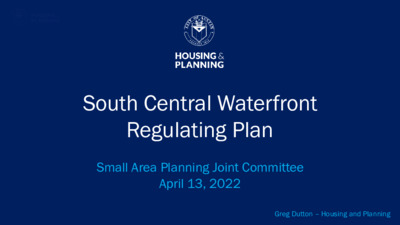Item 5b_SCW Reg Plan SAPJC 041322 — original pdf
Backup

South Central Waterfront Regulating Plan Small Area Planning Joint Committee April 13, 2022 Greg Dutton – Housing and Planning Content Background Regulating Plan How will it work? What will it do? What will it not do? Gives and gets Other Considerations Next Steps Waterfront Planning Background Town Lake Corridor Study (1985) Established principles to protect and promote shoreline Waterfront Overlay (1986) Incorporated into code (LDC) Determines what can or cannot be developed Waterfront Planning Advisory Board (2012) How to advance principles of TLCS South Central Waterfront small area plan initiated (2013) 3 4 5 Framework Plan (2016) 6 Overall Process Regulating Plan Creation Incorporation into LDC (Adoption) 7 Regulating Plan: how will it work? Developer Provides: • On-site affordable housing • Fee-in-lieu affordable housing • Other public realm benefits Developer Gets: • Increased entitlements 8 Regulating Plan: how will it work? Opt-in, voluntary Works in conjunction with existing WFO (does not replace it) Mechanically similar to University Neighborhood Overlay (UNO) Amendment to the land development code 9 Regulating Plan: what will it do? Control physical buildout Lay out public benefits and developer incentives Include requirements for Affordable Housing provided by private developments that utilize bonus entitlements Open space, streetscape, frontage, building height, land uses, parking 1 0 Regulating Plan: what will it not do? Does not mandate participation Does not speak to financing, funding sources, or public-private Does not allow wiggle room or negotiating Part of a larger toolbox - will not achieve the framework vision by partnerships itself 1 1 Regulating Plan: gives and gets* Public goods: Additional entitlements: Affordable housing Height subdistricts up to On and off-site, 10%+ 400’ set aside Improved streetscape Enhanced open space Improved pedestrian experience *All properties in the district eligible to participate Additional land uses Additional floor area No site area requirements No minimum parking required 1 2 Other Considerations TIRZ in process Project Connect: Blue Line stop (above ground) + bridge Orange Line stop (underground) Changed market since 2016 Acuña ruling 1 3 Next Steps Regulating plan: Concepts: April/May 2022 Draft code: June 2022 Adoption: July/August 2022 TIRZ: late summer 2022 20% Affordable Housing Gap Finance 1 4